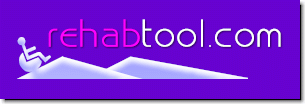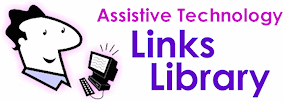|
Communication Aids
- Products and equipment designed to help persons with speech disabilities or writing difficulties to communicate. At its very simplest, augmentative communication can be a page with picture choices or alphabet letters that a person points to. It can also involve highly sophisticated speaking computers with on-screen communication boards and auditory or visual scanning. Common sub-categories are:
Speech and Augmentative Communication Aids
- Alternative and Augmentative Communication (AAC) involves alternate methods of communicating needs, feelings, ideas, and perceptions through the use of electronic and non-electronic devices that provide a means for expressive and receptive communication for persons with limited or no speech. Includes communication boards, speech synthesizers, text-to-speech software and hardware, head wands, light pointers, mouth sticks, signal systems, telephony equipment, etc.
Writing and Typing Aids
- Includes tactile devices, Braille devices, note taking devices, spelling devices, word prediction/completion software, modified typewriters, portable typewriters, etc. Does not generally include products intended to facilitate computer access and usage (see Computer Access Aids).

Back to Top
Computer Access Aids
- Hardware and software products that enables persons with disabilities to access, interact with, and use computers at home, work or school. Includes modified or alternate keyboards, switches activated by pressure, touch screens, special software, voice to text software, etc. Common sub-categories are:
Alternative Input Devices
- Includes alternative and adaptive keyboards, expanded keyboards ,Keyguards, alternative and ergonomic mouse/pointing systems, head-operated pointing devices, Eyeglaze pointing devices, mouth/tongue pointing devices, Morse code input devices, brain-actuated pointing devices, switches, touch screens, voice input systems, speech-to-text software, voice recognition/voice command software, dictation software, on-screen keyboards, cursor enlargement software, ergonomic computer-based equipment, etc.
Alternative Output Devices
- Computer-based output devices that generally enable Blind and Vision impaired persons to use or interact with a computer.
Includes Braille display/output devices, Braille embosser/printers, screen reading software, screen magnification/enlargement software, large print monitor, etc.
Accessible Software
- Includes software applications adapted for children and adults with disabilities, operating system accessibility options, accessible web browsers, etc.
Universal Design
- Design methods, techniques and guidelines for making computers and their applications fully accessible to people with disabilities.

Back to Top
Daily Living Aids
- Self-help devices that assist persons with disabilities in daily living activities such as dressing, personal hygiene, bathing, home maintenance, cooking, eating, etc. Includes reachers, adaptive clothing, modified eating utensils, adapted books, pencil holders, dressing aids, adapted personal hygiene aids, bathing accessories, feeding accessories, feeding devices, grab bars/grips/handles, grooming, hygiene, incontinent supplies, mechanical transfer lift, shower/bath chair, toileting accessories, transfer board, wheeled bath chair/commode, time management aids, specialized spoons for self-feeding, bathtub seats, etc. Does not generally include architectural/home adaptations or modifications (see Environmental Aids). Common sub-categories are:
Clothing and Dressing Aids
Eating and Cooking Aids
Home Maintenance Aids
Toileting and Bathing Aids

Back to Top
Education and Learning Aids
Cognitive Aids
- Includes cognitive software focusing on categorization, matching, association, reasoning, decision making, problem solving, memory skills, perceptual skills, talking word processing, word prediction/completion software, cognitive retraining or rehabilitation tools, etc.
Early Intervention Aids
Back to Top
Environmental Aids
- Environmental and structural adaptations that remove or reduce physical barriers for individuals with disabilities. Environmental adaptations usually involve building construction, engineering and architecture, but also include environmental controls and switches that can control an entire living environment. Common sub-categories are:
Environmental Controls & Switches
- Primarily electronic systems that enable someone with limited mobility to control various appliances, lights, telephone and security systems in their room, home or other surroundings. Includes Environmental Control Units (ECU), electronic appliance switches, switch mounting systems, home automation systems, signaling and alerting devices, home alarms, television adaptations, smoke alarm and telephone ringers, etc.
Home-Workplace Adaptations
- Includes worksite/school/home design or modification for accessibility, architectural accommodations, structural adaptations, building/home ramps, home elevators, wheelchair lifts, pool lifts, bathroom changes, automatic door openers, expanded doorways, adapted furniture, adapted doorknobs, alternative doorbells, lowered counters, specially designed bath areas, etc.

Back to Top
Ergonomic Equipment
- Low-tech assistive equipment or devices designed to reduce the likelihood of repetitive stress injuries often associated with work related situations. Includes adjustable workstations, industrial workstations, office workstations, adapted furniture, writing aids, modified seating and lighting, arm/wrist supports, back supports, etc. Does not generally include products intended to facilitate computer access and usage (see Computer Access Aids).
Hearing and Listening Aids
- Products designed to assist the Deaf and Hearing Impaired. Includes assistive listening devices, hearing aids, infrared/personal amplification systems, audio/FM loop systems, FM amplification systems, TV amplifiers, TV decoders, visual signaling and alerting systems, tactile alerting systems, telephony and accessories, text telephones, TDDs/TTYs devices, adapted phones, etc. Does not generally include products intended to facilitate computer access and usage (see Computer Access Aids).
Back to Top
Mobility and Transportation Aids
- Products that help mobility impaired persons move within their environment and give them independence in personal transportation. Includes standing/walking aids, transfer aids, stair lifts, walkers, scooters, wheelchairs and three-wheeled chairs, adapted bikes and Trikes, car seats/bed, stretchers, patient chairs, ramps, recliners, strollers, travel chairs, wheelchair trays, driving controls, seat belts, vehicle conversions, patient and wheelchair lifts, wheelchair loaders/carriers, wheelchair restraint systems, etc. Common sub-categories are:
Ambulatory Aids
- Includes canes, cane accessories, crutches, walkers, walker accessories, etc.
Scooters and Power Chairs
Wheelchairs
Vehicle Conversions
- Includes car-top carriers, custom cars and vans, adaptive driving control, hand-controls, child restraint systems, ramps, lifts, etc.

Back to Top
Prosthetics and Orthotics
- Replacement, substitution or augmentation of missing or malfunctioning body parts with artificial limbs or other orthotic aids. Includes splints, braces, foot orthosis, helmets, restraints, supports, etc.
Recreation and Leisure Aids
- Products that help persons with disabilities to participate in sports, social, cultural events. Includes modified sports equipment for skiing/biking/running/boating, audio description for movies, adaptive controls for video games, adaptive fishing rods, cuffs for grasping paddles or racquets, seating systems for boats, etc. Common sub-categories are:
Sports Aids
Toys and Games
Travel Aids
Back to Top
Seating and Positioning Aids
- Products that provide mobility impaired persons with greater body stability, maintain upright posture, provide trunk/head support and reduction of pressure to the skin. Includes adapted and modular seating, cushions and wedges, contour seats, lumbar support seats, standing tables, positioning belts, braces, wheelchair modifications and cushions, seat lifts, bolster chairs, corner chairs, therapeutic seats, postural support hardware, postural support systems, pressure monitors, etc.
Vision and Reading Aids
- Products designed to assist the Blind and Visually impaired. Includes auditory and speech output devices, reading machines, scanning/document reading systems, OCR systems, electronic book readers, talking equipment (clocks/watches, calculators, etc.), Braille devices, Braille transcription and translation devices, screen magnifier/enlarger, closed circuit television (CCTV) for magnifying documents, book holders, manual and electric page turners, large button phones, speaker phones, large print books, taped/audio books, etc. Does not generally include products intended to facilitate computer access and usage (see Computer Access Aids).
Services
- Support services for people with disabilities or their caregivers to help them select, acquire, or use adaptive devices. Services also include functional evaluations, training on or demonstration of devices, and purchasing or leasing devices.

Subscribe to our FREE Quarterly Newsletter - Read Past Issues
|








